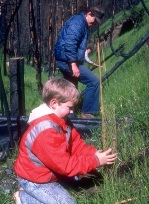
New Software Puts Environmental Price Tag on Urban Trees
Free i-Tree v.4 software quantifies the benefits of trees in environmental and economic terms.
The U.S. Forest Service and its partners released the newest version of their free i-Tree software suite, designed to quantify the benefits of trees and assist communities in gaining support and funding for the trees in their parks, schoolyards, and neighborhoods.
i-Tree v.4, made possible by a public-private partnership, provides urban planners, forest managers, environmental advocates, and students a free tool to measure the ecological and economic value of the trees in their neighborhoods and cities.
The Forest Service partnered on the project with The Davey Tree Expert Company, the National Arbor Day Foundation, the Society of Municipal Arborists, the International Society of Arboriculture and Casey Trees. The Forest Service and its partners will offer free and easily accessible technical support for the i-Tree suite.
“Urban trees are the hardest working trees in America,” said Forest Service Chief Tom Tidwell. “Urban trees’ roots are paved over, and they are assaulted by pollution and exhaust, but they keep working for us.”
Urban trees provide temperature control, clean water, clean air, and mitigate climate change by sequestering tons of carbon, said Tidwell.
The i-Tree suite of tools has helped communities of all sizes gain funding for urban forest management and programs by quantifying the value of their trees and the environmental services trees provide.
One recent i-Tree study found that street trees in Minneapolis provided $25 million in benefits ranging from energy savings to increased property values. Urban planners in Chattanooga, Tenn., were able to show that for every dollar invested in their urban forests, the city received $12.18 in benefits. New York City used i-Tree to justify $220 million for planting trees during the next decade.
“Forest Service research and models on the benefits of urban trees are now in the hands of people who can make a difference in our communities,” said Paul Ries, director of Cooperative Forestry for the Forest Service. “The work of Forest Service researchers, the best in the world, is not just sitting on a shelf, but is now being widely applied in communities of all sizes, around the world, to help people understand and leverage the benefits of trees in their communities.”
The most important improvements in i-Tree v.4:
- i-Tree will reach a broader audience in educating people on the value of trees. i-Tree Design is designed to be easily used by homeowners, garden centers, and in school classrooms.
- People can use i-Tree Design and its link to Google maps to see the impact of the trees in their yard, neighborhood, and classrooms, and what benefits they can see by adding new trees.
- i-Tree Canopy and VUE with their links to Google maps now also make it much easier and less expensive for communities and managers to analyze the extent and values of their tree canopy, analyses that up to this point have been prohibitively expensive for many communities.
i-Tree will also expand its audience to other resource management professionals. i-Tree Hydro provides a more sophisticated tool for professionals involved in stormwater and water quality and quantity management. Hydro is a tool that can be applied immediately to help communities evaluate and address the impacts of their urban forests on stream flow and water quality that could be helpful in meeting state and national clean water and stormwater regulations and standards.
Source: U.S. Forest Service